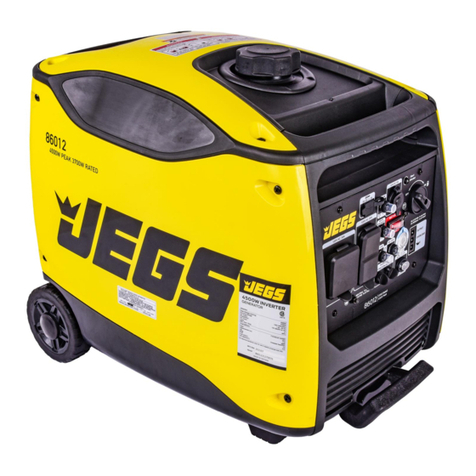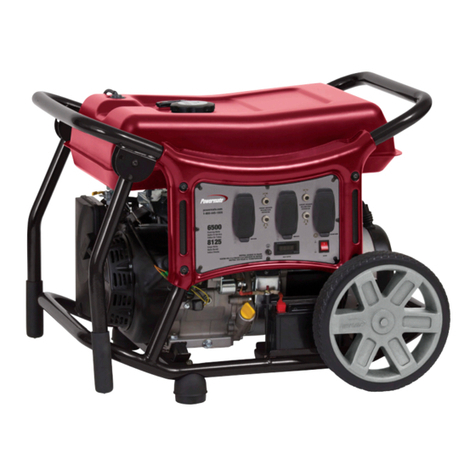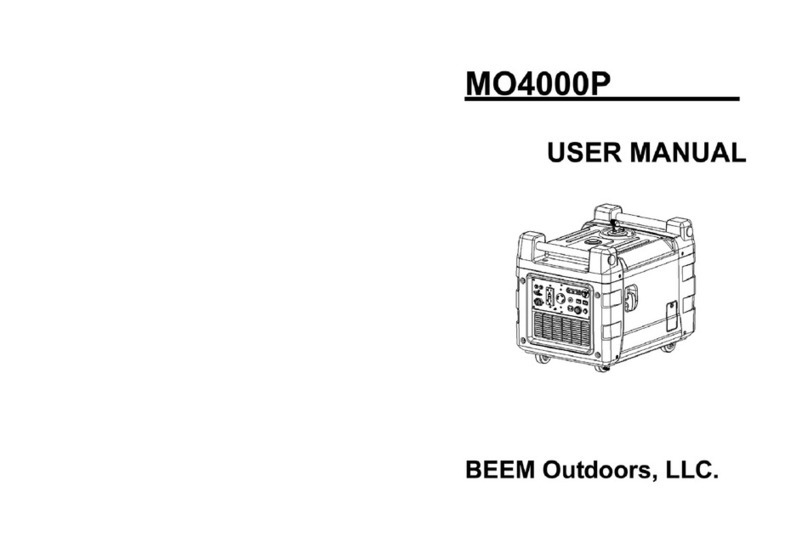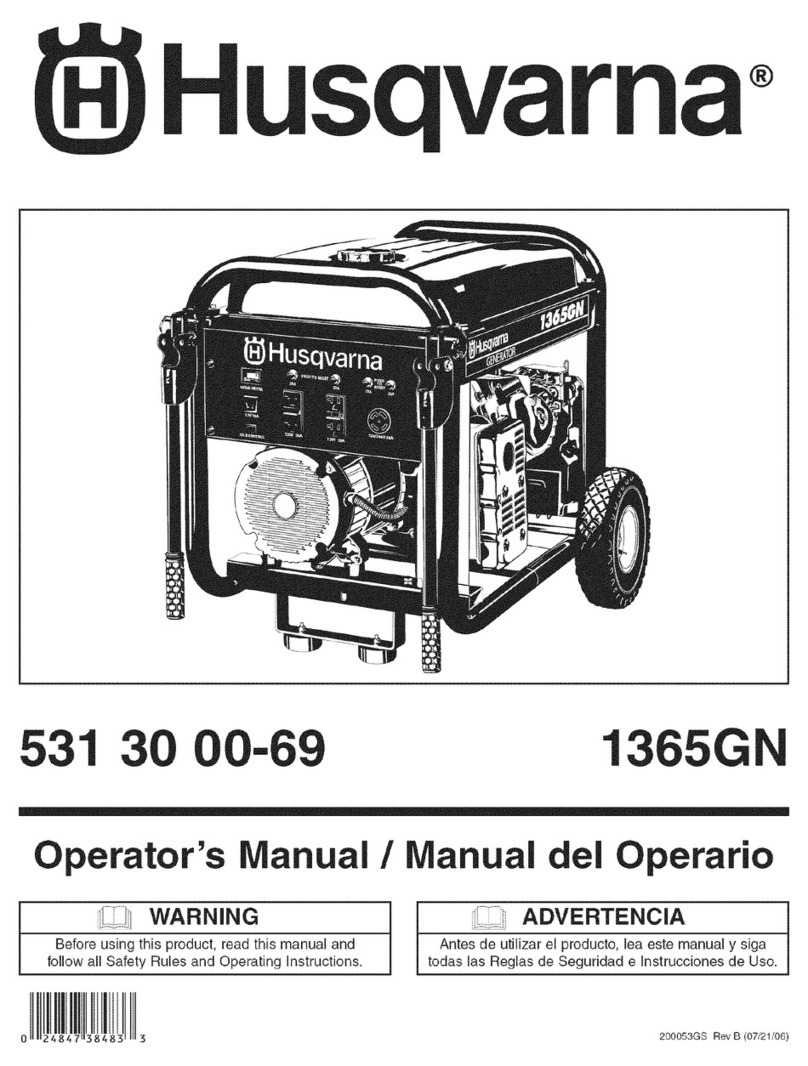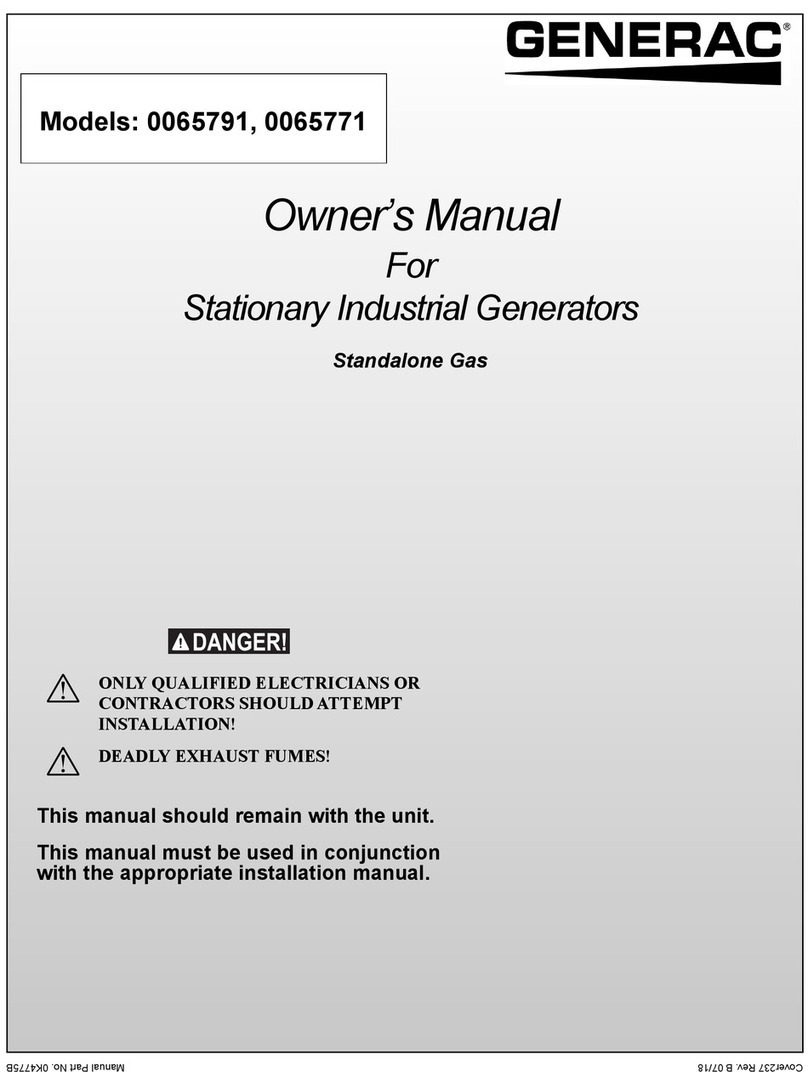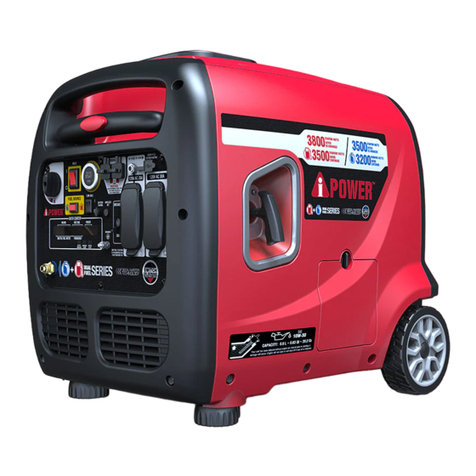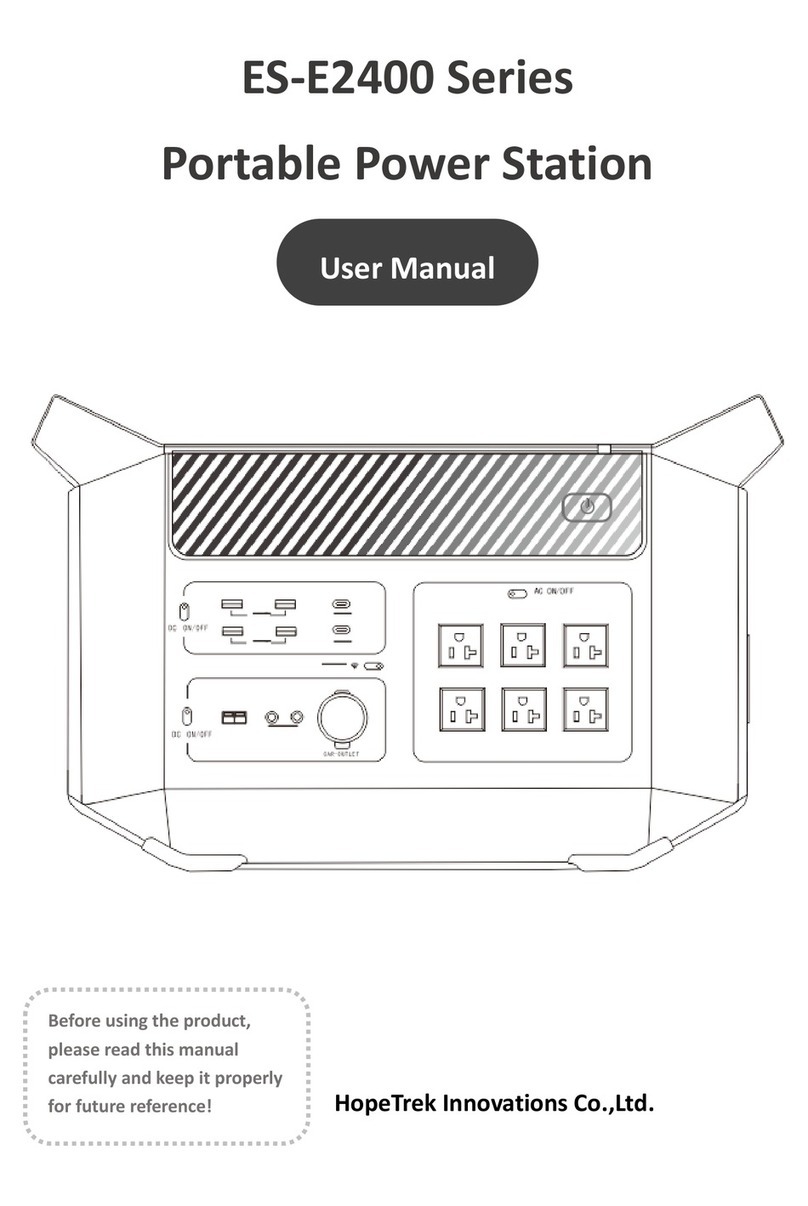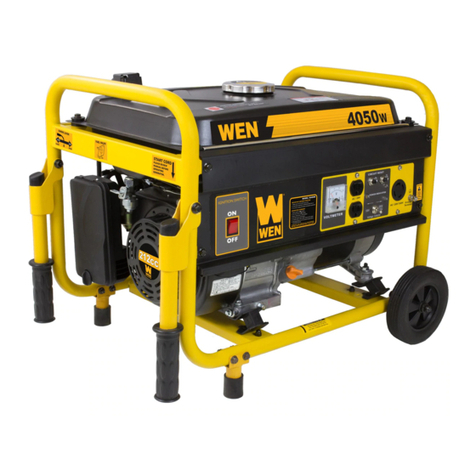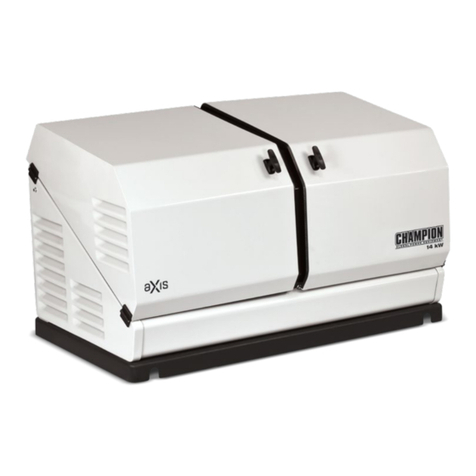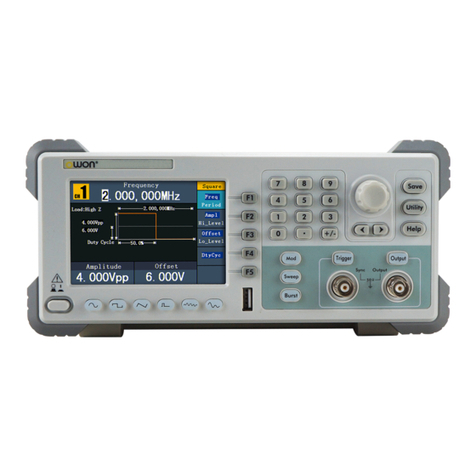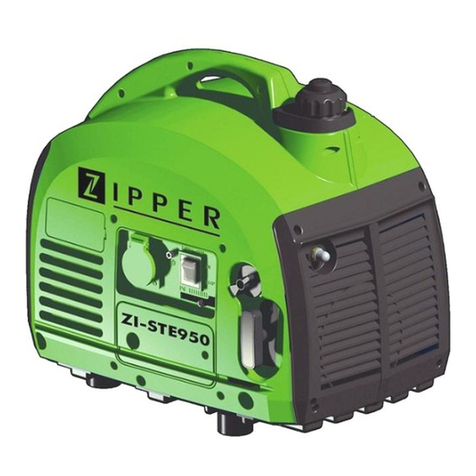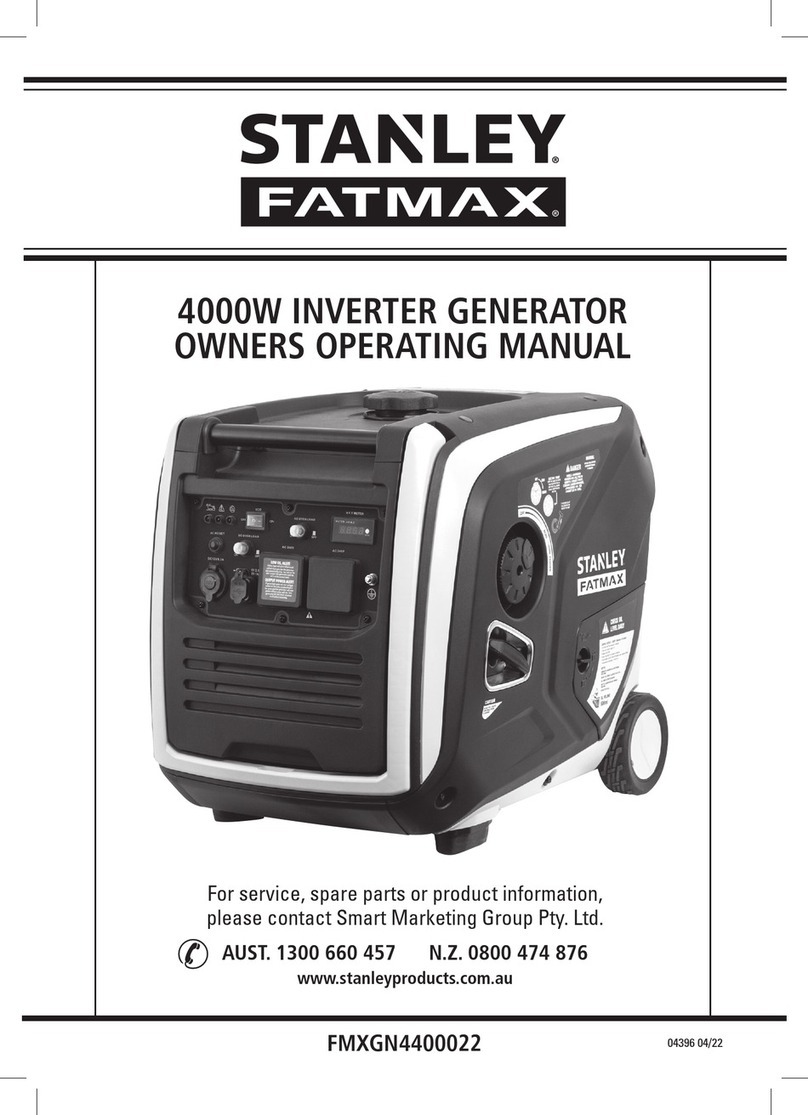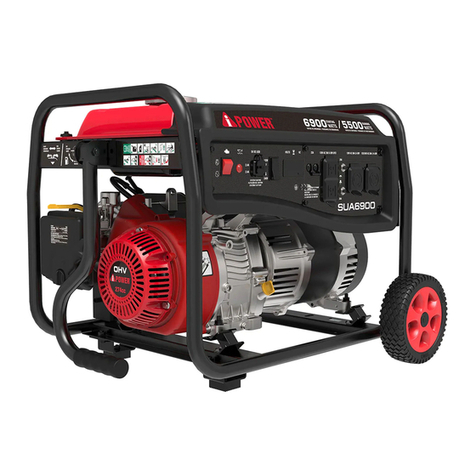Jegs 86004 User manual

User Guide for 86004
Generator
5250 Watt, Rated 4250 Watt

Table of Contents
1
Parts List...............................................................2
Introduction..........................................................3
Product Specifications......................................3
Customer Service .............................................3
Safety Rules.......................................................4-7
Safety Symbols....................................................4
Safety Instructions............................................4-6
Assembly.......................................................07-09
On/Off Switch & Choke........................................07
Packing List.....................................................07
Attaching Handle.............................................08
Attaching Wheels............................................08
Installing Leg Supports....................................08
Adding Oil.......................................................09
Adding Fuel....................................................09
Operation....................................................10-14
Grounding the Generator................................10
How to Start Engine.......................................10
Connect to an Electrical System......................10
How to Stop Engine.......................................11
Extension Cords...............................................12
Moving the Generator......................................12
Don’t Overload the Generator...........................12
Wattage Reference Guide...............................13
Power Management.........................................14
Cold Weather Operation..................................14
Maintenance..................................................14-18
Pre-Operation Steps........................................14
Maintenance Schedule....................................15
Changing Oil....................................................15
Check Spark Plugs..........................................16
Replace Air Filter..............................................16
Replace Fuel Filter...........................................17
Replace Spark Arrestor...................................17
Drain Carburetor.............................................18
Drain Fuel Tank...............................................18
How to Store..................................................18
Troubleshooting..................................................19
Diagram.............................................................20

2
Parts List 2
1On/Off Switch
2
3-in-1 Multifucntion Meter
(2) 120V Receptacles
120V 30 Amp RV Receptacle
Circuit Protectors
120V/240V 30Amp Twist Lock
Fuel Tank Vapor Vent
Oil Warning Light Indicator
Choke Lever
12V DC Output [For Batteries Only]
Fuel Valve [On/Off]
Grounding Connection
Recoil Starter Grip
Voltage Selector Switch
Air Filter
Handle
(2) Leg Supports
Fuel Tank
(2) Solid Rubber Wheels
6
7
8
9
15
16
17
18
19
10
3
4
5
11
12
13
14
5 6
7
8
9
10
11
12
1
3 4
13
14
16 19
17
18
15

Date of Purchase:
Model Number:
Serial Number:
3
Introduction
Safety Symbols
Thank you for purchasing this 5250 watt portable
generator from JEGS. This generator is designed to
give you years of reliable service when operated and
maintained as instructed in this manual.
Product Specifications:
This generator is an engine-driven, revolving field,
alternating current (AC) portable generator. It is
designed to supply electrical power to operate tools,
appliances, camping equipment, lighting, or serve
as a backup power source during power outages.
Indicates a hazardous situation which
could result in serious injury or death if
not avoided.
The emissions control system for this generator is
compliant with all standards set by the US EPA.
ModelSource 555-86002
Rated Wattage
Rated Voltage
Rated Frequency
Rated Ampere
Rated Output
Maximum Output
Displacement
Engine Type
Engine Oil Type
Engine Oil Capacity
Fuel Tank Type
Fuel Type
AC Output
Engine
4250W
120V/240V
60Hz
35.4A / 17.7A
4.25kVA
5.25kVa
224cc
Single Cylinder,
4-Stroke, OHV
Air Cooled
SAE 10w30
20 oz / 0.6 L
4 gal / 15L
Unleaded
How to Contact Customer Service:
If you have questions regarding your purchase please
contact customer service at: 1.800.345.4545.
Save your original sales receipt and record the
following information below for service or warranty
assistance.
Toxic Fumes
Risk of
Electric Shock
Risk of Fire
Hot Surface
Risk of Explosion
Lifting Hazard

Safety Rules
The manufacturer cannot anticipate every possible
circumstance that the user may encounter hazards.
Therefore, the warnings in this manual, on tags,
and on affixed decals are not all-inclusive. To avoid
accidents, the user must understand and follow all
manual instructions and use good common sense.
WARNING!
Read and understand
this manual in its entirety
before operating this
generator. Improper use of this generator
could result in serious injury or death.
•
Using a generator indoors CAN KILL YOU
IN MINUTES!
• Carbon monoxide gas is a poisonous, odorless
gas that can cause headache, confusion, fatigue,
nausea, fainting, sickness, seizures, or death. If
you start to experience any of these symptoms,
IMMEDIATELY get fresh air and seek medical
attention.
•
Never use indoors, in a covered area, or in a
confined space, even if the doors and windows
are open.
•
Install a battery-operated carbon monoxide alarm
near bedrooms.
•
Keep exhaust this unit produces from entering a
confined area through windows, doors, vents,
or other openings.
•
When working in areas where vapors could
be inhaled, use a respirator rated for carbon
monoxide protection.
The engine exhaust contains chemicals
that can cause cancer and birth defects.
To reduce the risk of serious injury, do
not attempt to lift the generator alone.
Never exceed the generator’s wattage/
amperage capacity. This may damage the
generator and/or connected devices.
Never start or stop the engine with
electrical devices plugged into the
receptacles. Failure to do so could damage the
generator and/or connected devices.
Starter recoil and other moving parts can
catch on clothing, jewelry, and hair.
• Always wash hands after handling generator.
•
Check operating voltage and frequency of all
electrical devices prior to plugging into generator.
•
Always start the engine and let it stabilize before
connecting any electrical devices.
•
Disconnect all electrical devices before stopping
the engine.
• Do not wear loose clothing or loose gloves.
•
Remove jewelry or anything else that could be
caught in moving parts.
• Tie back hair, or wear protective head covering
to contain long hair.
Do not operate indoors or in a confined
space that prevents dangerous carbon
monoxide gas from dissipating.
The generator must be properly grounded
to prevent electrocution.
• Only operate the generator on a level surface.
• If connected to a structure, connect the ground
terminal to an appropriate ground.
4

Safety Rules Cont.
Keep away from flammable objects
and other hazardous materials.
• The fuel and its vapors used to power this unit
are highly flammable and could explode resulting
in serious injury or death.
• Never fill or drain fuel tank indoors.
•
Never overfill fuel tank. If fuel spills, move the
unit at least 30 feet away from the spill and wipe
up any remaining fuel on the unit before starting
the engine.
• Never smoke while operating or fueling this unit.
•
Never operate or store this unit near an open
flame, heat, or any other ignition source.
• Generator should be far away from buildings or
other equipment during operation.
• Keep engine free of grass, leaves, grease, and
other flammable debris.
•
When adding or draining fuel, unit should be
turned off for at least 2 minutes to cool before
removing fuel cap. If unit has been running, the
fuel cap may be under pressure, remove slowly.
•
To keep fuel from spilling, secure unit so it cannot
tip while operating or transporting.
•
When transporting unit, disconnect the spark plug
wire and make sure the fuel tank is empty with
the fuel shutoff valve turned to the off position.
Pull cord recoils rapidly and can pull arm
towards engine faster than you can let go
which could result in injury.
•
To avoid recoil, pull starter cord slowly until
resistance is felt, then pull rapidly.
Avoid touching hot areas of this unit.
• Only operate the generator on a level surface.
• If connected to a structure, connect the ground
terminal to an appropriate ground.
This generator produces high voltage
which may result in burns/electrocution
causing serious injury or death.
•
Never handle the generator, electrical devices, or
any cord while standing in water, while barefoot,
or when hands or feet are wet.
•
Always keep the generator dry. Never operate
generator in rain or under wet conditions.
• Use a ground fault circuit interrupter (GFCI) in a
damp or highly conductive area, such as metal
decking or steel work.
•
Never plug electrical devices into generator hav-
ing frayed, worn, or bare wires. Never touch bare
wires or contact receptacles.
•
Never permit a child or unqualified person to
operate generator. Always keep children a
minimum of 10 feet away from the generator.
• If using the generator for backup power, notify
the utility company.
•
If connecting generator to a building’s
electrical system for standby power, you must use
a qualified electrician to install a transfer switch.
Failure to isolate the generator from the power
utility could result in serious injury or death to
electric utility workers.
Never modify this unit in any way or
modify governed engine speed.
•
Increasing the governed engine speed is
dangerous and can result in personal injury and/
or damaged equipment.
•
Decreasing the governed engine speed adds an
excessive load and can damage the equipment.
•
This generator will supply the correct rated
frequency and voltage only when operating at
the preset governed speed.
5

Only use as intended. Used incorrectly
serious injury or death could result.
• Do not bypass any safety device. Moving parts
are covered with guards. Make sure all protective
covers are in place.
•
Never transport or make adjustments to this unit
while it is running.
• Never insert objects into cooling slots.
Never operate this unit if there are any
broken or missing parts.
•
Improper treatment of this generator can shorten
it’s life.
•
Always repair this unit as specified in this manual.
•
Shut generator off if electrical output is missing,
unit vibrates excessively or begins to smoke,
spark, or emit flames.
Safety Rules Cont.
6

7
Assembly
Unpacking
1. Place box on a level surface.
2.
Remove all items from box except the generator.
Make sure all items listed on the packing list are
included and not damaged.
3. Cut down the sides of the box being careful to
avoid hitting the generator.
4.
Leave generator on box to install wheel assembly.
Packing List
Check all loose parts to the following list. Contact
your dealer if any loose parts are not included.
Description
Generator
Operator’s Manual
Spark Plug Wrench
Funnel
Handle
Handle Basket
Handle Clip
Screw
Nut
Wheels
Axles
Washers
Cotter Pins
Support Leg
Screws
Nuts
Qty
1
1
1
1
1
1
1
4
4
2
2
2
2
2
2
2

8
Assembly Cont.
Attaching the Handle (Figure 1)
1. Parts needed:
• 1 Handle
• 1 Handle bracket
• 1 Handle clip
• 4 Screws
• 4 Nuts.
2. Install handle bracket to generator frame.
3. Attach handle to the bracket handle.
4. Install handle clip.
Figure 1
Attaching the Wheels (Figure 2)
1. Parts needed:
• 2 Wheels
• 2 Axles
• 2 Cotter pins
• 2 Washers
2.
Raise or tilt generator so you can slide the wheel
axle pin into the wheel, the washer, the wheel
mounting hole located on the side of the frame.
3. Secure the wheel assembly by reinserting a hair
pin through hole at the end of the wheel axle and
pressing until it locks into place.
4.
Repeat process on the other side of the generator
to install the second wheel.
Figure 2
Installing the Support Legs (Figure 3)
1. Parts needed:
• 2 Support legs
• 4 M8 screws
• 4 M8 nuts
2. Tip the generator 90º on end to gain access to
the bottom of the frame. Securely position props
underneath to support.
3. Line up holes on the support leg bracket to the
holes on the front of the generator frame.
4.
Attach the support leg using M8 screws (2)
and nuts.
Figure 3

Assembly Cont.
Adding / Checking Engine Oil (Figure 4)
1. Place generator on a level surface.
2. Insert a funnel into the crankcase dipstick hole
and carefully add 4-Cycle engine oil (SAE 10W-
30) to empty crankcase until oil reaches the outer
edge of the oil fill hole (crankcase dipstick hole).
3.
Be sure to replace dipstick before attempting to
start the engine.
4.
To check oil, set generator on a level surface,
wipe dipstick clean, then reinsert dipstick without
rethreading.
You must add oil before first operating
this generator. Check level every use.
• DO NOT use E15 or E85 fuel in this unit. It is a
violation of federal law, will damage the generator,
and void your warranty.
9
Figure 5
Figure 4
Adding Fuel (Figure 5)
1.
Set the generator outdoors away from windows
and doors.
2. Remove fuel cap.
3.
Insert a funnel into the fuel tank and carefully pour
gasoline into the tank until fuel level reaches 1
½ inches below the top of the neck. Be careful
not to overfill the tank to provide space for
fuel expansion.

Generator must be properly grounded to
prevent electrocution.
Pull cord recoils rapidly and pulls arm
towards engine faster than you can let
go which could result in injury.
• Only operate generator on a level surface.
• Always connect the nut and ground terminal on
the frame to an appropriate ground source.
•
To avoid recoil, pull starter cord slowly until
resistance is felt, then pull rapidly.
10
Operation
This generator produces a very high
voltage which could result in burn or
electrocution causing serious injury or death.
•
Never handle the generator, electronic devices, or
any cord while standing in water, while barefoot,
or when hands or feet are wet.
•
Always keep the generator dry. Never operate
generator in rain or under wet conditions.
• Use a ground fault circuit interrupter (GFCI) in a
damp or highly conductive area, such as metal
decking or steel work.
•
Never plug electronic devices into generator
having frayed, worn, or bare wires. Never touch
bare wires or make contact with receptacles.
•
Never permit a child or unqualified person to
operate the generator. Keep children a minimum
of 10 feet away from the generator at all times.
• If using the generator for back up power, notify
the utility company.
•
Install a transfer switch. Failure to isolate the
generator from the power utility could result in
serious injury or death to electric utility workers.
How to Start the Engine
•
Place the generator on a level surface. All electrical
loads must be disconnected from generator.
• Turn fuel valve to the “ON” position. (See fig. 6)
•
Slide the choke lever to the “Choke” position.
(See fig. 7)
• Skip this step if the engine is hot.
•
For manual start, turn the engine ON/OFF switch
to the “ON” position. Pull the recoil handle (starter
cord) slowly until resistance is felt, then pull
rapidly. (See fig. 8)
•
Let engine run for several seconds and then
gradually, as engine warms up, slide the choke
lever towards the “RUN” position until the choke
is fully slid to the “RUN” position. (See fig. 9)
Connecting your Generator
to an Electrical System
If connecting the generator to a building’s electrical
system for standby power, you must use a qualified
electrician to install a transfer switch. The power from
the generator must be isolated from the circuit breaker
or alternative power source. The connection must
comply with all electrical codes and applicable laws.
Figure 6
Figure 8
Figure 7
Figure 9

Operation Cont.
11
Receptacles and Extension Cords
Only use high quality, well-insulated, extension cords
in good condition with generator receptacles.
This generator is equipped
with the following receptacles:
• Two 120 Volt AC, 20 Amp receptacles.
• One 120 Volt AC,30 Amp RV receptacle
•
120 / 240 Volt AC, 30 Amp twist lock receptacle
• (NEMA L14-30).
Do not connect 3-phase loads to the
generator.
•
Do not move the voltage selector switch with
devices connected. Disconnect all electrical loads
before moving the switch. Failure to do so could
damage the switch or generator.
• 12 Volt 8.3 Amp Output is for batteries only!
How to Stop the Engine
•
All loads must be disconnected from the
generator. Never start or stop the engine with any
electrical devices plugged in to the receptacles
(Fig. 10).
•
Turn the fuel valve to the “OFF” position (Fig. 11)
•
Turn the engine ON/OFF switch to the “OFF”
position (Fig. 12).
Figure 10
Figure 12
Figure 11
• 12 Volt 8.3 Amp Output
• (For charging batteries only)
120 Volt AC, 20 Amp receptacle
•
This receptacle has a 20 Amp push-to reset
circuit breaker to protect against overload.
•
Each socket is rated to operate 120 Volt, AC,
single phase, 60Hz loads requiring up to 2400
watts (2.4 kW) at 20 Amps.
•
Use extension cords having a minimum rating
of 125 Volts AC, 20 Amps.
120 / 240 Volt AC, 30 Amp locking receptacle
•
This receptacle has a 30 Amp push-to-reset
circuit breaker to protect against overload.
•
This receptacle is rated to operate 120 Volt, AC,
single phase, 60Hz loads requiring up to 3600
watts (3.6 kW) at 30 Amps. It is also rated to
operate 240 Volt AC, single phase, 60Hz loads.
• Use a NEMA L14-30 plug with this receptacle.
Voltage selector switch
This switch toggles between 120 volts and 240 volts,
AC output; on the respective receptacles.

12
Operation Cont.
Current
(Amps)
2.5
5
7.5
10
15
20
25
30
Load (Watts)
120V
300
600
900
1200
1800
2400
3000
3600
Maximum Cord Length (Feet)
#8 Wire
X
X
X
X
X
175
150
125
#10 Wire
1,000
500
350
250
150
125
100
65
#12 Wire
600
300
200
150
100
75
X
X
#14 Wire
375
200
125
100
65
X
X
X
#16 Wire
250
125
100
50
X
X
X
X
240V
600
1200
1800
2400
3800
4800
6000
7200
Extension Cord Selection
Refer to the above table to ensure the extension cord
used has the capacity to carry the required load.
If the size of the cable is inadequate it can cause
a voltage drop, which can damage the electrical
device and cord.
Moving the Generator
•
Disconnect any electronic devices from generator
then turn generator off.
• Turn fuel valve to the “OFF” position.
•
Tilt generator until it balances on wheels. Roll
machine to desired location.
• If the generator must be carried, fold handle to
the down position. Never lift or carry generator
by its handle.
This product is heavy and requires sever-
al people to lift. Lift and lower with your
legs by bending at the knees, not your back,
to avoid injury.
Don’t Overload the Generator
Make sure you can supply enough rated watts and
surge watts for all electrical devices connected to the
generator. Rated watts refer to the power a generator
must supply to keep a device running. Surge watts
refer to the power a generator must supply to start
an electrical device. This power surge for starting a
device usually lasts between 2-3 seconds but this
additional output must be taken into account when
selecting the electrical devices you plan to attach to
the generator. To prevent overloading the generator
take the following steps:
1. Add up the total rated wattage of all electronic
devices that will be connected to the generator
simultaneously.
2. Estimate surge watts by adding the item(s) with
the highest output (it is unnecessary to calculate
the surge output for all devices as they should
be connected one at a time).
3. Add the Surge Watts to the total Rated Watts in
step 1. Keep total load within generator’s power
capacity.

13
Operation Cont.
Operating Voltage and Frequency
Operating voltage and frequency requirement of
all electronic equipment should be checked prior
to plugging them into this generator. Damage may
result if the equipment is not designed to operate
within a +/- 10% voltage variation, and +/- 3 Hz
frequency variation from the generator name plate
ratings. To reduce the risk of damage, always have
an additional load plugged into the generator if solid
state equipment (such as television set) is used. A
power line conditioner is recommended for some
solid state applications.
Wattage Reference Guide
(Wattages listed are approximate. Check electrical
devices for actual wattage.)
Kitchen
Electric Range (1 element)
Dishwasher
Electric Oven
Electric Water Heater
Laundry Room
Iron
Washing Machine
Gas Clothes Dryer
Electric Clothes Dryer
Bathroom
Hair Dryer
Curling Iron
Family Room
X-Box or PlayStation
AM/FM Radio
DVD
TV or Monitor (40 in.)
Home Office
Fax Machine
Computer
Printer
Copy Machine
Power Tools
1000W Work Light
Airless Sprayer (1/3hp)
Reciprocating Saw
Circular Saw (7 1/2in.)
Miter Saw (10 in.)
Table/Radial Arm Saw
Electric Drill (5.4 Amps)
Hammer Drill
Air Compressor
Rated Watts
1500
1500
3500
4000
1200
1150
700
5400
1250
1000
40
10
100
200
65
800
250
700
1000
600
750
1400
800
1000
600
700
1600
Surge Watts
1500
2000
3500
4000
1200
2400
1500
6750
1250
1000
40
10
100
200
65
800
950
800
1000
800
950
2300
1200
2000
900
1000
4500
Essentials
75 W Light Bulbs
18 Cu. Ft. Refrigerator
Furnace Fan (1/2hp)
Sump Pump (1/2hp)
Water Pump (1/2hp)
Heating/Cooling
Dehumidifier
Table Fan
Window AC (10k BTU)
Central Air (4 ton)
Electric Blanket
Space Heater
Kitchen
Blender
Toaster (2 slices)
Coffee Maker
Rated Watts
75 ea.
800
800
1000
1000
650
200
1200
1500
400
1800
300
1000
1500
Surge Watts
75 ea.
2200
2350
2000
3000
800
300
3600
6000
400
1800
900
1000
1500

14
Operation Cont.
3-in-1 Meter
The multifunction meter operates whenever the
engine is running and keeps track of how many
hours, frequency, and voltage is being used on
the generator.
Power Management
• Start the engine without anything connected to
the generator.
•
When the engine has stabilized, plug in and turn
on first load. It is strongly recommended to plug
in devices with the largest power requirement
first and the smallest power requirement last to
help prevent overloading the generator.
• Allow generator output to stabilize (engine and
attached devices run evenly) before plugging in
the next load.
Cold Weather Operation
Under humid conditions where temperatures drop to
40ºF (4ºC) the carburetor and/or crankcase breather
system may begin to freeze. To prevent icing take
the following steps:
• Replace any old fuel with clean, fresh fuel.
• Use synthetic 5W-30 or SAE 5W-30 engine oil.
Check oil daily or after every 8 hours of use.
•
Ensure generator is serviced according to the
maintenance schedule under “Maintenance”
section of manual.
• Shelter unit from elements.
Never exceed the generator’s wattage /
amperage capacity. This could damage
the generator and / or connected devices.
Maintenance
Regular Maintenance
Regular maintenance will extend the life of this unit
and improve its performance. The warranty does
not cover items that result from operator negligence,
misuse, or abuse. To receive full value from the
warranty, operator must maintain the generator as
instructed in this manual, including proper storage.
Pre-Operation Steps
Before starting the engine, perform the following
pre-operation steps:
•
Check the level of the engine oil and the fuel
gauge level. Add oil or fuel as needed.
• Make sure the air filter is clean.
•
Remove any debris that has collected on the
generator and around the muffler and controls.
Use a vacuum cleaner to pick up loose debris. If
dirt is caked on, use a soft bristle brush.
• Inspect the work area for hazards.
After Each Use
Follow the following procedure after each use:
• Shut off engine.
• Store unit in a clean and dry area.
Before inspecting or servicing this
machine, make sure the engine is off and
no parts are moving. Disconnect the spark plug
wire and move it away from the spark plug.

Maintenance Cont.
15
After 8 Hours
or Daily
After First
5 Hours
Annually
(25 hr. Usage)
Annually
(100 hr Usage)
Clean debris from generator
and air filter area
Change engine oil
Check engine oil level
Check and clean air filter
Change engine oil after the first
25 hours, again at 50 hours,
and then every 100 hours after.
Inspect condition of muffler and
spark arrestor
Service spark plug
(Replace with NGK BP6ES,
Champion N9YC, or equivalent)
Inspect fuel valve and fuel lines
for leaks or damage
Inspect condition of muffler and
spark arrestor
Check and clean the air filter
assembly. Replace air filter
Clean cooling system cylinder
head fins and flywheel fan
Maintenance Schedule
Note:
• Below 40º F (4º C) the use of SAE 30 will result
in hard starting.
•
Above 80º F (27º C) the use of 10W-30 may
cause increased oil consumption. Check oil level
more frequently
Changing Engine Oil (Figure 13)
• Run the generator until the engine is warm.
• Place generator on a level surface.
• Remove the crankcase dipstick.
•
Place an oil pan underneath the oil drainage bolt
to collect used oil.
•
Remove the oil drainage plug and allow oil to
drain completely.
• Reinstall oil drainage plug, tighten securely.
• Carefully add SAE 10W-30 to empty crankcase
until the oil reaches the outer edge of the oil fill
hole (crankcase dipstick hole).
• Replace crankcase dipstick.
Continued on next page.
Figure 13 Figure 14

Used oil should be disposed of at an
approved disposal site. See your local oil
retailer for more information.
Operation Cont.
16
Oil Recommendations (Figure 14)
• Do not use special additives.
• Outdoor temperatures determine the proper oil
viscosity for the engine. Use the chart to select
the best viscosity for the outdoor temperature
range expected.
Air Filter (Figure 15)
A dirty air filter will reduce the life span of the engine,
make it difficult to start the engine, and reduce the
unit’s performance.
• To clean, remove the air filter cover.
• Carefully pull the air filter out by lifting up along
the edges.
•
Remove dirt from filter by tapping on it or having
it blown out. Replace with new filter annually.
• Reinstall air filter so that it seals and replace air
filter cover.
Checking Spark Plugs (Figure 16)
• Disconnect the plug wire from the spark plug.
• Before removing the spark plug, clean the area
around its base to prevent debris from entering
the engine.
• Clean carbon deposits off the electrode with a
wire brush.
•
Check the electrode gap and slowly adjust to
0.762 mm - 0.80 mm (.030 - .031”) if necessary.
• Reinstall spark plug and tighten to Torque 22.0
– 26.9 Nm (16-20 ft-lbs).
• Reconnect spark plug wire.
• If the spark plug is worn replace it only with an
equivalent replacement part.
• Spark plug should be replaced annually.
• Torch F6TC
• NGK BP6ES
• Champion N9YC
• Or Equivalent
Figure 15
Spark Plug Gap
•
0.030-0.031 in.
•
0.762-0.80 mm
Spark Plug Torque
• 16-20 ft-lbs
• 22.0-26.9 Nm
Figure 16

Maintenance Cont.
17
Consult your local hazardous waste
management in your area for the proper
way to dispose of used fuel.
Spark Arrestor (Figure 17)
•
Inspect the spark arrestor for breaks or holes.
Replace if necessary.
•
Use a brush to remove carbon deposits from the
spark arrestor screen as needed.
• To remove the spark arrestor: While the muffler
is cool, loosen the locking clamp and slide the
spark arrestor out of the muffler. Reverse this
process to install it.
Carburetor Adjustment
The carburetor is low emission and is equipped with
a non-adjustable idle mixture valve.
Replacing the Fuel Filter (Figure 18)
• Turn the fuel valve to the “OFF” position.
• Remove the fuel line from both sides of the filter
by squeezing the retaining clip ends with pliers.
• Slide the fuel line off.
• Replace with new fuel filter.
• Reinstall fuel lines to new fuel filter.
• Turn the fuel valve to the “ON” position.
Prevent Old Fuel Issues
To help prevent gum deposits in the fuel system,
drain the fuel from the tank and carburetor before
storing the unit for long periods of time. This will help
prevent starting problems in the future. If the unit is
stored with fuel and the fuel becomes stale or turns
gummy or to varnish the warranty does not cover
this repair or service.
Figure 17
Figure 18

18
Maintenance Cont.
Draining the Fuel Tank
• Turn the engine OFF.
• Turn the fuel valve to the OFF position.
•
Push the fuel valve knob through the valve holder
bracket allowing you to access the petcock.
•
Remove the fuel line that leads to the carburetor
from the petcock by squeezing the ends of the
hose clamps and sliding the fuel line off.
• If needed, install a fuel hose that will extend to a
suitable fuel container large enough to catch the
fuel being drained from the tank.
• Turn the fuel valve to the ON position.
• When the fuel has drained from the tank, close
the fuel valve and reinstall fuel line securely
on petcock.
•
Reinstall the fuel valve knob in the valve bracket.
Push forward until knob snaps securely
into position.
Draining the Carburetor
• Turn the engine OFF.
• Turn the fuel valve to the OFF position.
•
Position a suitable container under the carburetor
drain screw to catch fuel; loosen the screw.
• Allow fuel to drain completely into container.
• Re-tighten drain screw.
Storage
•
Remove any debris that has collected on the
generator and around the muffler and controls.
Use a vacuum cleaner to pick up loose debris. If
dirt is caked on, use a soft bristle brush.
•
Inspect air cooling slots. Remove any debris
if obstructed.
• Disconnect negative battery cable from battery.
•
For short-term storage, start generator once
every 7 days.
•
For long-term storage, add fuel stabilizer to pre-
vent stale fuel from causing acid and gum de-
posits in the fuel system and carburetor.

19
Troubleshooting
Generator is running, but AC
output is not available.
Engine runs well without
load, but bogs down when
loads are connected
Engine will not start, shuts
down during operation,
or starts and runs rough.
Engine lacks power
Engine “hunts” or falters
Problem Cause Solution
1. Open circuit breaker
2. Poor connection
3. Defective cord set
4. Connected device is faulty
5. Fault in generator
1. Reset circuit breaker
2. Check and repair
3. See above step (#2)
4. Connect a device that is
working properly
5. Contact tech sales
1.
Short circuit in connected
device
2. Generator is overloaded
3. Clogged fuel filter
4. Engine speed is too slow
5. Short circuit in generator
1. Disconnect device
2.
See “Don’t overload generator”
on pg. 12
3. Clean or replace fuel filter
4. Contact tech sales
5. See above step (#4)
1. On/Off switch set to “Off”
2. Dirty ar filter
3. Clogged fuel filter
4. Out of fuel or Stale fuel
5.
Spark plug wire disconnected
from spark plug
6. Bad spark plug
7. Water in fuel
8. Fuel valve in “Off” position
9. Over-choking
10.Low oil level
11.Engine has flooded
12.Loss of engine compression
1.
Turn switch to “Choke” then
pull recoil starter.
2. Clean or replace air filter
3. Clean or replace fuel filter
4. Replace fuel
5. Reconnect spark plug wire
6. Clean or replace spark plug
7.
Drain fuel tank and replace fuel
8.
Turn fuel valve to “On” postion
9. Turn off choke
10.Check oil level
11.Wait 5 minutes and re-start
12.Contact tech sales
1. Generator is overloaded
2. Clogged fuel filter
3. Dirty air filter
4. Engine needs servicing
1.
See “Don’t overload generator”
on pg. 12
2. Clean or replace fuel filter
3. Replace air filter
4. Contact tech sales
1.
Choke was removed too soon
2. Clogged fuel filter
3.
Carburetor is running too rich
or too lean
1. Adjust choke
2. Clean or replace fuel filter
3. Contact tech sales
Table of contents
Other Jegs Portable Generator manuals
